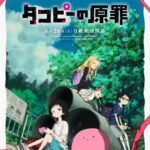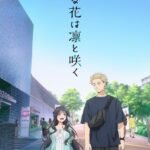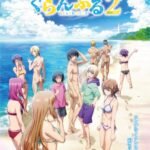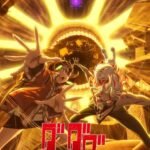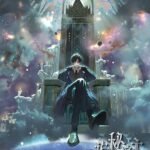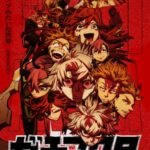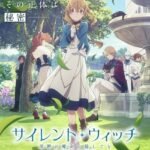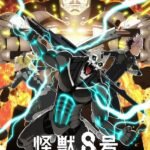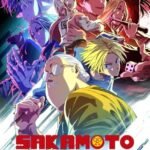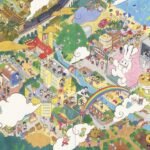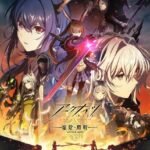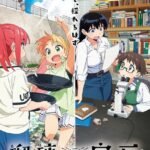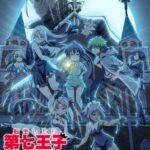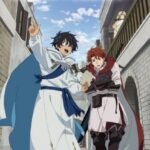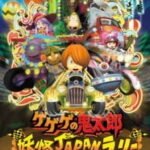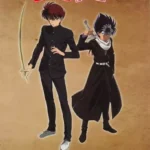Hakaba Kitarou
Graveyard Kitaro / 墓場鬼太郎
| Genres: Horror, Supernatural | |
| Studios: Toei Animation | |
| Producers: Asmik Ace, Dentsu, Fuji TV, Fujipacific Music, SKY Perfect Well Think, Sony Music Entertainment, Yomiko Advertising | |
| Rating: 6.86 / 10 | |
| Rank: #5138 | |
| Popularity: #6157 | |
| Users Listed: 13,309 | |
| Users Scored: 4,514 | |
| NSFW: No | |
| Last Updated: 12/25/2024 | |
| Aired: January 11, 2008 – March 21, 2008 (Winter) | |
| Type: tv | |
| Source: manga | |
| Age Rating: PG 13 | |
| Episodes: 11 | |
| Broadcast: Friday at 00:45 (JST) |
Synopsis:
In a world where the veil between the human and spirit realms is thin, *Kitarou* follows a young youkai boy navigating a complex coexistence. Born in a cemetery, Kitarou is one of the last of his kind, dedicated to maintaining a fragile peace between humans and the often mischievous spirits that populate the world. He confronts supernatural threats, acting as a protector for humanity against those who would exploit or disrupt their lives.
The series draws heavily from its manga origins, offering a grounded portrayal of yokai folklore rather than sensationalized action. Kitarou’s quiet determination and unique perspective provide a thoughtful exploration of cultural differences and the challenges of understanding those perceived as "other." The atmosphere is steeped in a sense of melancholic beauty, reflecting the delicate balance between the living and the departed.
You May Also Like:
Episodes:
- Episode 1: The Birth of Kitaro (Aired: 01/11/2008)
- Episode 2: Yaksha vs Dracula IV (Aired: 01/18/2008)
- Episode 3: The Vampire Tree (Aired: 01/25/2008)
- Episode 4: Neko (Aired: 02/01/2008)
- Episode 5: The Fake Kitaro (Aired: 02/08/2008)
- ... and 6 more episodes
Characters:
- Kitarou (Main) - Voice Actors: Nozawa, Masako
- Medama Oyaji (Main) - Voice Actors: Tanonaka, Isamu
- Adobarana (Supporting)
- Caroline (Supporting)
- Elite (Supporting)
- Fake Kitarou (Supporting) - Voice Actors: Ikura, Kazue
- Homerun Teahouse Master (Supporting)
- Kitarou's Mother (Supporting) - Voice Actors: Suzuki, Reiko
- Mizuki (Supporting) - Voice Actors: Ookawa, Tooru
- Mizuki, Shigeru (Supporting) - Voice Actors: Shimada, Bin
- Neko (Supporting) - Voice Actors: Nakagawa, Shoko
- Nezumi Otoko (Supporting) - Voice Actors: Otsuka, Chikao
- Obake Times Editor (Supporting)
- Yasha (Supporting)
Staff:
- Hosokai, Kousuke (Producer)
- Umezawa, Atsutoshi (Producer)
- Kimura, Makoto (Assistant Producer)
- Chioka, Kimitoshi (Director, Storyboard, Series Production Director)
- Gotou, Yasunori (Episode Director)
- Hatano, Kouhei (Episode Director)
- Ishiguro, Megumu (Episode Director)
- Kakudou, Hiroyuki (Episode Director, Storyboard)
- Nakamura, Kenji (Episode Director, Storyboard)
- Ueda, Hidehito (Episode Director, Storyboard)
- Hasegawa, Keiichi (Script)
- Takahashi, Ikuko (Script)
- Satou, Junichi (Storyboard)
- Denki Groove (Theme Song Composition, Theme Song Performance, Theme Song Lyrics, Theme Song Arrangement)
- Nakagawa, Shoko (Theme Song Lyrics, Theme Song Performance)
- Taki, Pierre (Theme Song Performance, Theme Song Lyrics)
- nishi-ken (Theme Song Arrangement)
- Amemiya, Hideo (Key Animation)
- Aoyama, Mitsuru (Key Animation)
- Hakamada, Yuuji (Animation Director, Key Animation)
- Hineno, Yuuko (Key Animation)
- Iguchi, Chuuichi (Key Animation)
- Iizuka, Youko (Key Animation)
- Ikai, Kazuyuki (Key Animation)
- Ishikawa, Mariko (Key Animation)
- Itou, Masato (Background Art)
- Katsumata, Aiko (Background Art)
- Kawamori, Noboru (Key Animation)
- Kinoshita, Yumiko (Key Animation)
- Kouno, Megumi (In-Between Animation, Key Animation)
- Kubo, Mariko (Key Animation)
- Kurahashi, Takashi (Art Director)
- Maejima, Hiroshi (Key Animation)
- Maruyama, Masahiko (Key Animation)
- Matsumoto, Masako (Key Animation)
- Mizuki, Shigeru (Original Creator)
- Nakano, Ryouko (Key Animation)
- Nakatsuru, Katsuyoshi (Key Animation)
- Narita, Yoshimi (Series Composition)
- Nishikawa, Masato (Key Animation)
- Oonishi, Youichi (Animation Director)
- Sasakado, Nobuyoshi (Key Animation)
- Satou, Michio (Key Animation)
- Shimoji, Ayaka (In-Between Animation)
- Soga, Atsushi (Animation Director)
- Tachiguchi, Noritaka (Key Animation)
- Takeda, Yoshihiro (Key Animation)
- Tanaka, Shiho (Key Animation)
- Tokiwa, Shouji (Background Art)
- Tsujita, Kunio (Color Design)
- ... and 1 more staff
Reviews:
-
User z-pak (Score: 7/10):
Hakaba Kitarou is the sixth adaptation of the original Hakaba Kitarou manga, which is more known as Gegege no Kitarou. It is a rather strange series that has a nice blend of comedy and horror. From the description and art, it may seem "kiddie", like the other Gegege no Kitarou adaptations, but it is far from it. This series has quite a sense of humor, so those who like dark comedy may like this series. Story: Hakaba Kitarou does not actually have an overarching plot. Most of the episodes can stand on their own, and there is very little connection between what happens from theprevious episode to the next one, with the exception of one or two of the episodes. The titular character, Kitarou, is the last living descendant of the Ghost Tribe, and it is basically a story of his various encounters with different supernatural beings. The story in each of the individual episodes are interesting and a bit peculiar. The only downside though is that they become repetitive after the halfway point. A few of the later stand alone episodes felt like they were following a standard formula with variations here and there.nnArt: The art director, Takashi Kurahashi, is the same guy who did the wonderful art direction in Mononoke. I loved it there and I loved it here. The art style fits nicely in this series and is very distinct as each of the monster designs are original and unique. The series tends to use dark, gloomy colors, which nicely sets up the atmosphere, but when it uses brighter colors, it makes those colors more vibrant. This series also uses a lot of camera angles so the animation may seem a bit stiff in some parts. nnSound: This series uses its soundtrack effectively to set up the atmosphere and mood. And unlike a lot of anime soundtracks, where they use musical scores and pieces, this soundtrack uses a lot of sounds. One of such often heard sounds is the clucky wood-hitting-on-wood sound. They also nicely utilize ghostly, supernatural sounds. The opening is very catchy, upbeat, and different from your usual OP, as it shows panels of the manga. It has also become one of my favorites. The ending, however, could have been better and is a bit bland compared to its wonderful opening. The voice acting is also very good, though I was a bit surprised at first by how low Kitarou sounded when he first spoke. His chuckle is very creepily well done. nnCharacters: The majority of the cast are morally ambiguous. No one is entirely good and no one is entirely bad. You first have Kitarou, who is definitely not your average goody good shoe protagonist. He does things based almost purely on his own benefits. Then you have Nezumi Otoko, also called the Rat Man, who shows some antagonistic tendencies towards Kitarou, but is not exactly one. He is rational, and like Kitarou, does things if it benefits him. The side characters also show… -
User davidman001 (Score: 7/10):
The concept of Youkai has stood the test of time for hundreds of years, and whether or not they truly exist has been a thought pondered throughout its history. However, knowing the truth about their existence isn’t as important when Youkai have undoubtedly played an influential role in Japanese art, history, culture, and identity. Youkai can be found everywhere in modern art, especially being referenced or playing huge roles in video games and anime. The modern revitalisation of Youkai can be traced back to the heavily influential manga Gegege no Kitarou by Shigeru Mizuki, which popularised Youkai culture in the mainstream in the 1960s. Gegegeno Kitarou’s idea of Youkai was that of creatures who had stories to be told, creatures that needed to be understood. Kitarou, the main character of the series, made it his mission to allow Youkai and humans to live in harmony. He wants to befriend both sides in the hopes that youkai and humans can understand each other. The themes and ideas represented in Gegege no Kitarou were undoubtedly incredibly influential, with anime like Natsume Yuujinchou and even Youkai Watch sharing a lot of common themes with Kitarou.nnHakaba Kitarou represents almost none of these ideas. In fact, this series is almost the complete opposite of everything Gegege no Kitarou and its subsequent influences stood for. It’s actually impressive how different Hakaba is from its counterpart. So, the question now is: just what exactly is Hakaba Kitarou?nnNot to be confused with the renaming of the Weekly Shounen Magazine version of Hakaba Kitarou, which changed to Gegege no Kitarou in 1967, Hakaba Kitarou’s anime adapts the stories told in the Kashi-hon release of Hakaba Kitarou in 1959. This version of the story is much more gruesome and cynical than its counterpart, and this is seen most clearly in its characters. Hakaba’s take on the character of Kitarou is that of a self-fulfilling asshole, only seeking to perform actions that benefit himself and no one else. This is reflected in the episodes where Kitarou straight-up curses other humans, something you never see his future counterpart do. But, to give him credit where credit is deserved, Kitarou specifically curses those who are greedy and cause harm to others. But still, Kitarou doesn’t seek to unite Youkai and humans; on the contrary, he seems to have fun seeing humans being tormented. Throughout the anime, Kitarou seems to take a backseat, not really intervening with the Youaki or humans. This is an interesting difference from Gegege, since Kitarou in the main series acts as a hero who’s there to save the day. While there are moments where Kitarou’s humanity is shown, like in the Neko Musume story, Kitarou never shows any sign of alignment. He’s neither good nor bad, creating this moral ambiguity that the viewer can never be certain about.nnHakaba isn’t afraid to show death in the most gruesome of ways possible, with many of its characters dying a horrible, and I mean horrible, death. There’s even a character who is… -
User Gorenko (Score: 8/10):
Those who are frequent with Japanese Occultism must know about Kitarou and Nurarhiyon because they have been famous for their anime adaptation. And those who love to dwell in Japanese Ghost stories must have heard of or watched Ge Ge Ge no Kitarou (Spooky Kitarou) in their life. So what is different between Hakaba Kitarou (Graveyard Kitarou)- HK for short - and Ge Ge Ge no Kitarou (Spooky Kitarou) - GKfor short? Well, GK has been serialized and reanimated from the 1960s till 2018 almost 5 to 6 times and every time it has been about the haunting ghosts creating problems for normal humans andKitarou will save the day by purging these 'Bad Ghost or Demon, Obāke. But what about HK? Well, it's a new concept by Shigeru Mizuki sensei, the mangaka of these anime's manga, who crafted a new Kitarou who is not your hero but the Ghost Child. Watching GK, I have always wondered... There are ghosts in this anime but why is it not 'Spooky' as the title suggests? Umm... It is for children who got scared easily by any horror tale or story. GK is like the friendly Ghost stories that any grandparents would like to tell their grandchildren. But HK is not like that because it redefines the Kitarou from his horrified beginning from his birth and how this newborn child with the blood of Ancient Ghost Descendant or Clan will bring some spooky phenomenon to this world. nFor the story, I would like to give it - an 8, because it distinctly differs from the GK, and though some of the stories like Horror ride of the broken rail car, or Johnny the Vampire have been adapted from original work they hold their uniqueness in the retelling of the story and somewhat gloomy environment.nFor art, I should've given 9 but 8 would be sufficient. To talk about art, I have watched the black and white version of the 1960s up to the vibrant colorful version of 2007, each adaptation has brought its individualism but what is most amazing about HK is that it doesn't follow the old pattern but it brings out the very eerieness in the background of the very story. The darkened screen with less vibrant but effectively dense colors gives HK its very own horror surroundings.nSound... Well, it is 8 for me, again! Background music or Soundtrack gives you the spookiness of its own. You know, you're watching a horror anime but is it horror anime if there is no eerie sound of screeching door or heavy wind? HK gives you that pleasure.nCharacter.... I'll say 9!! Why? Because I liked it that much! By omitting the original group of Kitarou's team members like Ittan Mommen and 3 more ghosts, this anime didn't lack any proficiency. But it did include Nezumi Ōtoko and somewhat Neko Onna in their sense. Without Nezumi Ōtoko there will never be anime comedy in Kitarou. And this Child Kitarou was like the Kitarou you'll never imagine because…
Forum Topics:
- Hakaba Kitarou Episode 1 Discussion
- Hakaba Kitarou Episode 3 Discussion
- Hakaba Kitarou Episode 11 Discussion
- Hakaba Kitarou Episode 9 Discussion
- Hakaba Kitarou Episode 6 Discussion
- Hakaba Kitarou Episode 2 Discussion
- Hakaba Kitarou Episode 4 Discussion
- Hakaba Kitarou Episode 7 Discussion
- Should I watch this?
- Hakaba Kitarou Episode 8 Discussion
- Hakaba Kitarou Episode 5 Discussion
- Hakaba Kitarou Episode 10 Discussion
- Subbers?
- Who's Going To Watch?
External Links:
Related Anime/Manga:
- Hakaba Kitaro (manga - Adaptation)
- Gegege no Kitarou (1968) (anime - Spin-Off)
- Gegege no Kitarou (1971) (anime - Spin-Off)
- Gegege no Kitarou (1985) (anime - Spin-Off)
- Gegege no Kitarou (1996) (anime - Spin-Off)
- Gegege no Kitarou (2007) (anime - Spin-Off)
- Gegege no Kitarou (2018) (anime - Spin-Off)
- Ehon Yose (anime - Character)
